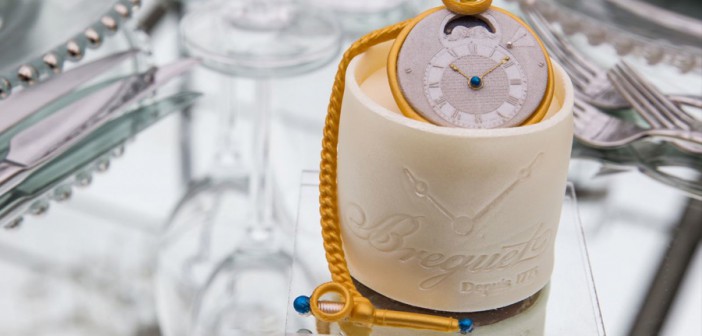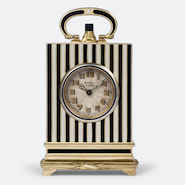
An Art Deco period clock by Breguet
In a challenging environment caused by economic and geopolitical unrest, luxury brand marketers can quell the worries of affluent consumers by effectively leveraging brand history, according to an executive from Swiss watchmaker Breguet.
The fine watch industry has been impacted by recent uncertainty in China and Russia and the introduction of smartwatches, while the luxury sector as a whole has been affected by an unstable stock market. At Luxury FirstLook: Strategy 2016 Jan. 20, Breguet’s brand manager discussed the state of the luxury watch market before delving into how those in the industry can use heritage-based efforts as a reflection of stability, consistency and trust.
“When you’re crafting a marketing campaign, you need to know who you’re targeting,” said Mike Nelson, brand manager of Breguet U.S. “I think there are a few things that remain true no matter who the customer is, especially at this time when there’s so much turmoil in the world, and so much uncertainty.
“How can you build, convey the consistency and stability, and ultimately build trust with these consumers?” he said. “I think it is something Breguet has done very well. And that’s leveraging our history to engage the modern consumer.”
Luxury FirstLook: Strategy 2016 was organized by Luxury Daily.
In times of turmoil
During the “State of the Luxury Watch Market: Leverage Brand History to Engage With the Luxury Consumer” session, Mr. Nelson touched on what has impacted the fine watch sector in the last 12 to 18 months.
In this time, there has been a crackdown in China on luxury gifting and corruption, which for watchmakers has shown a greater impact since Chinese consumers are the number one buyers of timepieces. Also, sanctions on Russia and the devaluation of its currency has resulted in lessened travel and spending by Russian consumers.
The rise and fall of the stock market has also presented challenges for the industry, but there is a silver lining in the strong U.S. dollar. The current strength of the U.S. dollar and an improving U.S. economy has increased tourism and purchases made abroad.
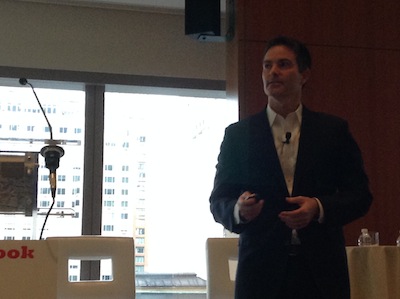
Mike Nelson of Breguet at Luxury FirstLook: Strategy 2016
Also, just as the definition of luxury has shifted, the average affluent consumer is not categorized in the same way as in the past. Mr. Nelson cheekily recalled a Breguet consumer who visited a boutique in shorts, a T-shirt and a $100,000 timepiece, showing that today, there is no set list of characteristics for a luxury consumer.
Despite turmoil and challenges, brand marketers can use a three-pronged strategy to target consumers. Brand communications must show stability to prove to consumers that the brand will be around for decades to come; consistency in product, message and service through the extent of the consumer relationship and trust, meaning that year after year a brand delivers on promises regardless of economic or geopolitical uncertainty.
Prove it
To achieve the stability, consistency and trust objectives, Mr. Nelson suggests leveraging history to engage with today’s consumer.
First, brands should start with product and build campaign communications based on heritage. Mr. Nelson explained that for Breguet this means incorporated aspects of past creations, no matter how subtle, into modern-day designs.
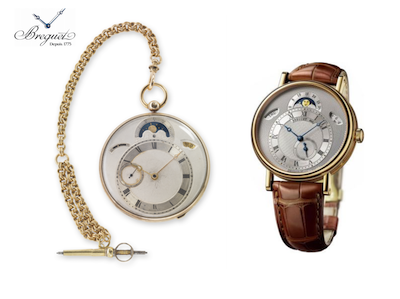
Historical pocket watch and modern wristwatch created by Breguet
Breguet takes this approach because a brand cannot have disconnect between what its marketing says and what is produced for today’s market. Designing timepieces with a historical connection aligns with Breguet’s overall message while establishing an emotional bond with its consumers.
This aligns with Breguet’s CRM tactics that help consumers understand that the brand is not chasing current fads, but rather creating modern timepieces that will not go out of style. To highlight this Breguet keeps in-depth records housed in Paris.
Breguet’s archival registry program keeps a record of every owner of its timepieces, dating back to the 18th century. Having physical proof of the brand’s staying power is appreciated by value-minded and brand conscious consumers who can see their own names with the likes of Marie Antoinette and Winston Churchill.
Additionally, promotion is vital for Breguet to market its watches and brand message. The watchmaker commonly partners with top international museums such as The Louvre and The Hermitage to create a “halo effect,” leveraging the partner’s qualities.
Most recently, Breguet partnered with the Legion of Honor Museum in San Francisco to present horologists in the Bay Area the opportunity to learn more about the brand’s innovative works.
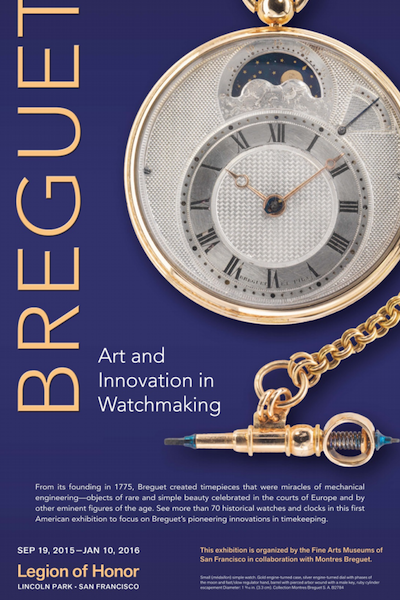
Exhibition poster
The exhibit, titled “Breguet: Art and Innovation in Watchmaking” opened on Sept. 19 at the California Palace at the Legion of Honor Museum, and was open through the new year, closing Jan. 10. On display was the Swatch-owned watchmaker’s largest collection of antique timepieces ever shown to consumers in the Americas.
Breguet gathered more than 70 pocket watches, clocks and horological instruments dating back to the time of brand founder Abraham-Louis Breguet and his successors for the exhibit.
The pieces culminated to underscore Breguet’s timepieces as “miracles of mechanical engineering and objects of rare beauty celebrated in the courts of Europe by the world’s most preeminent personalities” (see story).
Breguet’s out of home, digital and user-generated promotions for the exhibit led to 55,000 visitors during its three-month run and an increase in Web traffic.
By conveying a sense of stability, consistency and trust, Breguet established credibility through its partnership, all by starting with its product.
“I think one of the words that stands out is ‘history,’ and within history there is the keyword ‘story,’” Mr. Nelson said. “It’s about creating that story about the brand, which does create the meaning.
“In a short cut kind of way, partnering with these museums and other institutions helps to create that meaning in the customers’ minds,” he said. “That’s what we’re after, we’re after the mind of the consumer so they understand what [our] brand is about.”

